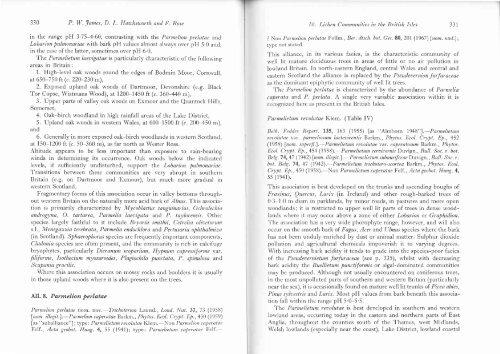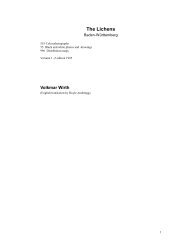Lichen communities in the British Isles: A preliminary conspectus
Lichen communities in the British Isles: A preliminary conspectus
Lichen communities in the British Isles: A preliminary conspectus
Create successful ePaper yourself
Turn your PDF publications into a flip-book with our unique Google optimized e-Paper software.
330 P. W. James, D. L. Hawkszrorth and 1-. Rose<br />
<strong>in</strong> <strong>the</strong> range pH 3-75-+.60, contrast<strong>in</strong>g with <strong>the</strong> Parmelion 1>erltttae antl<br />
Lobarion pulmonariae with bark pH valucs almost always over pH 5.0 and,<br />
<strong>in</strong> <strong>the</strong> case of <strong>the</strong> latter, somet<strong>in</strong>es over pIJ 6'0.<br />
The Parmelietum laeoigatae is particularly characteristic of <strong>the</strong> follow<strong>in</strong>g<br />
areas <strong>in</strong> Brita<strong>in</strong>:<br />
1. High-level oak woods round <strong>the</strong> edges of Bodm<strong>in</strong> Moor, Cornu,all,<br />
at 650-750 lt (c.220-230 m),<br />
2. Exposed upland oak woods of Dartmoor, Devonshire (e.g.<br />
Tor Copse, Wistmans Wood), at 1200 1450 ft (r. 360-440 m),<br />
3. Upper parts of valley oak woods on Exmoor and <strong>the</strong> Quantock<br />
Black<br />
Hills,<br />
Somerset,<br />
4. Oak-birch woodland <strong>in</strong> high ra<strong>in</strong>fall areas of <strong>the</strong> Lake l)istrict,<br />
5. Upland oak lr,'oods <strong>in</strong> r,vestern \Vales, at 600-1500 ft (c. 200-450 m),<br />
and<br />
6. Generally <strong>in</strong> more exposed oak-birch woodlands <strong>in</strong> western Scotland,<br />
at 150-1200 ft (c. 50-360 m), as far north as Wester Ross.<br />
Altitude appears to be less important than exposure to ra<strong>in</strong>-bear<strong>in</strong>g<br />
w<strong>in</strong>ds <strong>in</strong> determ<strong>in</strong><strong>in</strong>g its occurrence. Oak woods below <strong>the</strong> <strong>in</strong>dicatecl<br />
levels, if sufficiently undisturbed, support <strong>the</strong> Lobarion pulmonariae.<br />
Transitions between <strong>the</strong>se <strong>communities</strong> are very abrupt <strong>in</strong> sou<strong>the</strong>rn<br />
Brita<strong>in</strong> (e.g. on f)artmoor and Exmoor), but much more gradual <strong>in</strong><br />
western Scotland.<br />
Fragmentary forms of this association occur <strong>in</strong> valley bottoms throughout<br />
u'estern Brita<strong>in</strong> on <strong>the</strong> naturally more acid bark of Alnus. This association<br />
is primarily characterized by Mycoblastus sangu<strong>in</strong>arius, Ochrolechia<br />
androgyna, O. tartarea, Parmelia laeoiga.ta and P. tayl.orensis. O<strong>the</strong>r<br />
species largely faithful to it <strong>in</strong>clude Bryoria smithii, Cetrelia oliz.etorunt<br />
s.1., Menegazzia terebrata, Parmelia endochlora and Pertusaria ophthalmiza<br />
(<strong>in</strong> Scotland). Sphaerophorzs species are frequently important components,<br />
Cladonia species are often present, and <strong>the</strong> community is rich <strong>in</strong> calcifugc<br />
bryophytes, particularly Dicranum scoparium, Hypnum cupressiforme var.<br />
fliforme, Iso<strong>the</strong>cium myosuroides, Plagiochila punctata, P. sp<strong>in</strong>ulosa anrl<br />
Scapania gracilis.<br />
Where this association occurs on mossy rocks and boulders it is usually<br />
<strong>in</strong> those upland woods where it is also present on <strong>the</strong> trees.<br />
Al1. 8. Parrnelion perlatae<br />
Jtarmelion perlatae nom. nov. Trichoterion Laund., Lontl. Nat. 37, 73 (1958)<br />
lnom. illegit.].-Pannelion caperatae Barkm., Phytos. Ecol. Crypt.,l,/r., 450 (19-59)<br />
fas "suballiance"] ; type: Parmelielum reztolutae KIem. l\on Parmelion caperoto?<br />
Felf., Acta geobot. Htntg.4,55 (1941); type: Parmelietu'm ca1>erutae lelf.<br />
10. <strong>Lichen</strong> Comm.unitie.r <strong>in</strong> <strong>the</strong> Britislt <strong>Isles</strong> 331<br />
?Nonl)arnrelionperlatae Iiollm., Ber.dtsch.bot.Ges.80,201 (1967)lnom.nud.];<br />
type not stated.<br />
This alliance, <strong>in</strong> its various facies, is <strong>the</strong> characteristic community of<br />
well lit maturc dcciduous trees <strong>in</strong> areas of little or no air pollution <strong>in</strong><br />
lor.r'land Brita<strong>in</strong>. In north-eastern England, central Wales and central and<br />
eastcrn Scotland <strong>the</strong> alliance is replaced by <strong>the</strong> Pseudexernion.furfuraceae<br />
as thc dom<strong>in</strong>ant epiphytic community of well lit trees"<br />
The I'armelion perlatae is characterizedby <strong>the</strong> abundance of Parmelia<br />
caperata and P. perlata. A s<strong>in</strong>gle very variable association with<strong>in</strong> it is<br />
recognized here as present <strong>in</strong> <strong>the</strong> <strong>British</strong> <strong>Isles</strong>.<br />
Parmelietum revolutae Klem. (Table IV)<br />
Beih. Feddes llepert. 135, 163 (1955) [as "Almborn 1948"1.-Parm.elietum<br />
rexoluta.e var. parm.eliosum, laeteoirezfri' Barkm., Phytos. Ecol. Crypt. Ep., 452<br />
(1958) lnom. .utperfl.].-Parmelietum rez;olutae var. caperatosum Barkm., Phytos.<br />
Ecol. Crypt. Ep., 454 (195U). Parmelietum cerxicornis Duvign., Bull. Soc. r. bot.<br />
8e1g.74,.47 (1942)lnom.illegit.].-Parmelietumsubauriferae Duvign., Bull. Soc.r.<br />
bot. Ilelg. 74, +7 (1942).--Parmelietum trichotero-scortea Barkm., Phytos. Ecol.<br />
Crypt. l|p.,450 (195S).-Non Parmelietum caperataeFelf ., Acta geobot. Llung.4,<br />
ss (1e41).<br />
This association is best developed on <strong>the</strong> trunks and ascend<strong>in</strong>g boughs of<br />
Frax<strong>in</strong>us, Quercus, Larix (<strong>in</strong> Ireland) and o<strong>the</strong>r rough-barked trees of<br />
0'3-1'0 m diam <strong>in</strong> parklands, by m<strong>in</strong>or roads, <strong>in</strong> pastures and more open<br />
woodlands; it is restrictcd to upper u.ell lit parts of trees <strong>in</strong> dense woodlands<br />
wlrerc it may occur above a zone of ei<strong>the</strong>r Lobarion or Graphidion.<br />
Thc association has a very wide phorophyte range, however, and will also<br />
occur on <strong>the</strong> smooth bark of Fagus, Acer and (.tlmus species where <strong>the</strong> bark<br />
has not been unduly enriched by dust or animal matter. Sulphur dioxide<br />
pollution and agricultural chemicals impoverish it to vary<strong>in</strong>g degrees.<br />
With <strong>in</strong>creas<strong>in</strong>g bark acidity it tends to grade <strong>in</strong>to <strong>the</strong> species-poor facies<br />
of thc Pseudevernietum furfuraceae (see p. 335), whilst r.vith decreas<strong>in</strong>g<br />
bark acidity <strong>the</strong> Buellietum punctiformes or algal-dom<strong>in</strong>ated <strong>communities</strong><br />
mav be produced. Although not usually encountered on coniferous trees,<br />
<strong>in</strong> <strong>the</strong> most unpolluted parts of sou<strong>the</strong>rn and western Brita<strong>in</strong> (particularly<br />
near thc sea), it is occasionally found on mature u'ell lit trunks of Picea abies,<br />
P<strong>in</strong>us sylxestris and Larix. Most pII values from bark beneath this association<br />
fall with<strong>in</strong> <strong>the</strong> range pH 5'0-5'5.<br />
'l'he Parrnelietum reztolutae is best developed <strong>in</strong> sou<strong>the</strong>rn and western<br />
lorvland areas, occurr<strong>in</strong>g today <strong>in</strong> <strong>the</strong> eastern and nor<strong>the</strong>rn parts of East<br />
Anglia, throughout <strong>the</strong> counties south of <strong>the</strong> Thames, west lVlidlands,<br />
Welsh lowlanc{s (especially near <strong>the</strong> coast), Lake District, lowland coastal





